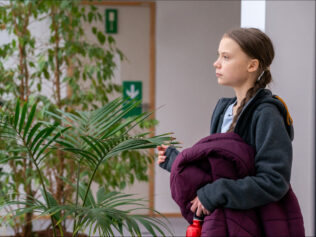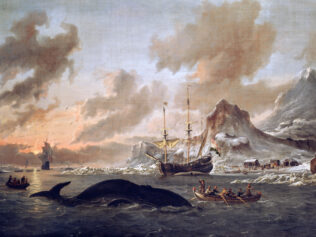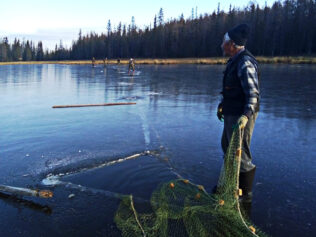
Ah, kids these days. They want to fix everything, to clean everything up.
Today’s youth waste no time trying to change the world (with varying levels of success). They start early, because they know that soon there might be nothing left to change.
A child cannot think ‘like an adult’, but they can, in their own childlike way, consider serious issues that grown-ups are occupied with. Their lack of knowledge and experience forces the children to think differently.
Janusz Korczak
Greta’s gang on the barricades
“My generation has failed to respond properly to the dramatic challenge of climate change. This is deeply felt by young people. No wonder they are angry,” said secretary general to the United Nations, António Guterres, in support of the school climate strikes, initiated by 16-year-old Greta Thunberg from Sweden. Her determination has inspired young people around the globe to take an interest in environmental issues and to rebel against the indifference of politicians responsible for the climate. As a way of protesting, she launched mass school truancy action.
Instead of attending school on 15th March 2019, 1.5 million young people from around 125 countries went to demonstrations to fight for their future. In Poland, thousands of youth walked in the rain on the streets of Warsaw, Poznań, Opole, Kraków, Katowice, Zielona Góra, Szczecin, Gdańsk, Ełk, Lublin, Świdnica, Białystok, Toruń, and many other cities. For many of the protesters, it was the first demonstration they had ever attended (as it was in the case of my six-year-old daughter). More marches took place on 12th April and 24th May. The participants claim that they will not give up until global governments meet their demands of implementing the Paris Agreement, accepting the IPCC Special Report as the basis of climate change action, and introducing necessary changes to the school curriculum.
“Over the entire course of my education, from primary school to high school, I had just a single one-hour lesson about climate,” says 17-year-old Julia Bartoszewicz from the S.I. Witkiewicz High School in Warsaw, who is a participant in the Youth Climate Strike. “My school strongly supports the Youth Climate Strike, so our geography teacher organized a lesson based on an interview with Dr Marcin Popkiewicz, an expert on climate change. Unfortunately, it is more difficult to teach without textbooks,” says Antoni Wiśniewski-Mischal, a 17-year-old student from the Jacek Kuroń Multicultural High School in Warsaw, who volunteers as a spokesperson for the Youth Climate Strike in Poland.
The Strike is coordinated by a group of 30 people in Warsaw, who run public money collections and work with 120 members of working groups in other cities. “When it comes to defending the climate, we’ve got to the point where any step towards a change, even just a change in thinking, is incredibly precious,” Antoni explains. “For a long time now, I was frightened by the scope of climate change and its consequences, but I was pessimistic about it. I couldn’t imagine that I could do anything about it on my own, as an individual,” adds 19-year-old Ewa Rewers from the Nicolaus Copernicus High School in Warsaw. “The Youth Climate Strike both in Poland and across the world gave me hope and made me realize that we can at least give it a try,” she says.
Felix plants trees
When Felix Finkbeiner was preparing a school presentation on climate change, he came across an article on Professor Wangarĩ Maathai from Kenya, a feminist, environmental activist and Nobel Peace Prize laureate, who founded the Green Belt Movement in Africa. Maathai mobilized other women, who together planted 30 million trees within 30 years to prevent desertification of the continent, as well as the poverty and hunger that come with it.
Felix thought that he and his friends could do something similar. He concluded his presentation with an appeal: “Let’s plant a million trees in every country!” His classmates, excited about the idea, planted their first tree on 28th March 2007. Felix read his presentation to the rest of his school and then started speaking in other schools. One year later, there were 50,000 more trees in Germany. Three years later, the number grew to one million! Felix and his friends set up a website and drafted the programme of their new initiative: Plant-for-the-Planet.
In 2009, Felix and Wangarĩ met for the first time in New York during the UN General Assembly. Two years later, the baton was symbolically passed on – Wangarĩ passed away, and Plant-for-the-Planet took over managing her Billion Tree Campaign for adults. “You will be proud of us while looking down to Earth,” Felix wrote in his diary. The Plant-for-the-Planet initiative grew into a worldwide movement, connecting children from 193 countries. Felix is 21 years old today. Together with other activists, he wrote a book called Tree by Tree to teach young people what they can do for the climate. The Plant-for-the-Planet motto is: ‘Stop talking. Start planting.’
Kids from Poland plant several hundred trees a year within the Plant-for-the-Planet initiative. When asked in the Polish edition of Tree for Tree why they participate in this movement, Ula and Kamil from Borek said: “Trees are the lungs of the world, and there can be no life without them. They are also a beautiful symbol. In our school, every first-grade pupil plants a tree behind our school building. This way, they can watch the tree grow together with them. Also, there were seven million trees destroyed in our region during a big storm, so that’s one more reason to plant some more.”
The first tree planted by Felix is still growing next to the entrance to his school in Bavaria. It is now over three metres tall.
To learn more, visit www.plant-for-the-planet.org.
The stubborn sisters from Bali
The paradise in Bali is gone. The island, famous for its fairytale beaches and picturesque temples, is now drowning in rubbish left by tourists – there are five million visitors each year. Add the 3.4 million people inhabiting Bali and numerous industrial plants, all squeezed onto a piece of land 145 kilometres long and 80 kilometres wide.
When Melati Wijsen was 10 and her sister Isabel was 12, they started their social movement for young activists, Bye Bye Plastic Bags. The girls teach locals how to sort their rubbish. They convince shopkeepers not to pack groceries in plastic bags, and they tell bar owners to eliminate plastic straws and cups. Melati and Isabel organized a large-scale Bali cleaning initiative, where they mobilized 20,000 people to collect 65 tonnes of plastic waste. Another idea they came up with was River Booms – barriers that catch rubbish in rivers to prevent it from getting into the ocean. The girls did everything that they could, but plastic waste kept drowning their island. Finally, they began a hunger strike. Only then did the island’s governor meet with them and agree to help.
Eventually, the government of Bali admitted that the island is dealing with an ecological disaster. They announced a state of emergency, closed miles of beaches, and sent the army in to clean the rivers. In early 2019, Indonesia announced the introduction of an ecological tax that would contribute to waste removal. The same year, a total ban on single-use plastic bags will be introduced. After five years of campaigning, the sisters have achieved their goal.
Today, Melati is 15 and Isabel is 17. The sisters now preside over an international organization that operates in 25 countries.
To join them, visit www.byebyeplasticbags.org and start your own team.
How Boyan cleaned the ocean
In 2011, Boyan Slat, a high-school student from the Netherlands, went to Greece for a diving holiday. But when he went underwater, he saw more plastic bags than fish. The sight has haunted him ever since. The boy decided that there must be a way to clean the oceans, and that he would find out what it is. Boyan worked on this problem in a school project and then presented his idea at a TEDx conference in Delft. Several people congratulated Boyan on his presentation, but for a few months, nothing happened. Finally, in March 2013, something started ticking. All around the world, people started watching his video on the internet. Boyan decided to make the most of this sudden interest and started collecting money. In just three weeks, he raised $80,000 and disappeared from the public eye to work on his plan to save the world.
He was almost 18, and he wanted to tackle the problem of giant rubbish islands floating on the oceans. Boyan decided to use natural sea currents and winds. He decided to create an arched, floating barrier that would collect any debris that drifted inside. Every now and again, a support vessel would come to the barrier to collect the plastic waste and transport it for recycling. Boyan found a group of experts, started The Ocean Cleanup NGO, and set up a fundraiser online. 38,000 people from 160 countries donated over $2 million, and investors added a further $30 million.
Many people were impressed with the story of this young hero. King Harald V of Norway awarded Boyan the Young Entrepreneur Award; he also received the Champions of the Earth award from the United Nations Environment Programme, and was recognized as one of the 20 Most Promising Young Entrepreneurs Worldwide. Boyan became a media star. However, many experts point out flaws in his project: the barriers won’t stop tiny pieces of microplastic, they can’t remove the waste that lies on the ocean floor, and many floating living organisms will die because of the cleaning process (creatures that Boyan didn’t even know existed).
The Ocean Cleanup project was launched on 8th September 2018. However, the 610-metre-long cleaning barrier broke after 116 days. It was taken back to the port. The organization promised that after the barrier is fixed and undergoes further tests, it will return to the ocean. Boyan Slat doesn’t seem to be too worried about the setback. On Twitter, he wrote that the project did not fail – the organization was already planning for the system to return for more tests and development. Just in case, he has also started studying aerospace engineering. Some say he already has an idea for how to clean up space…
Ann and the magic torch
“I’m eighteen years old, and I’ve never had a phone,” says Ann Makosinski, walking around the stage in her tight leather trousers and pink heels. It’s 2015, and Ann is speaking at the TEDx Teen conference. “My parents never gave me that many toys. I never had a Tamagotchi, Nintendo, a Wii or an Xbox, nothing. What they gave me, however, was a hot glue gun, and I had to make my own toys. I was put in a position where I was almost forced to be creative in solving one of the first problems you have as a kid, which is: How do I keep myself entertained?” says Ann, standing against the backdrop of a childhood photo, in which she plays with transistors as a toddler.
In 2012, Ann Makosinski – a Canadian-born girl of half-Polish, half-Filipino heritage – invented a hollow flashlight, powered by the heat of human hands, which won her first place in her age group at the Google Science Fair. The young inventor was inspired by a conversation with her friend from the Philippines, who failed at school because her family couldn’t afford to pay their electricity bills, which meant the girl couldn’t study in the evenings. Ann decided to help her friend and started to look for a free source of energy. She read that the human body emits as much warmth as a 100-watt lightbulb. All she had to do was to find a way of turning that heat into electricity.
Ann spent $26 on her supplies: Peltier tiles (which generate energy with the temperature difference), a transformer, LED lights and an aluminium tube. When touched with a human hand, the Peltier tile generates about 5 milliwatts of power, which is also the minimum wattage needed to turn on an LED light. Even though the tile doesn’t generate enough voltage, this problem is solved by the transformer. Ann installed the tiles onto the wall of the aluminium tube, then added an electric system and LED lights on top. When she held the finished product in her hand, it lit up.
Ann Makosinski’s invention has brought her fame. In 2016, she was voted the 2016 Popular Science Young Inventor of the Year, and Teen Vogue’s Global Earth Angel. In 2017, she was listed on the Forbes ‘30 Under 30’ list. Today, Ann Makosinski studies English Literature at the University of British Columbia and is working on her first book. “I believe it’s important to maintain a balance between science and art,” she said in an interview with CBC.
Ann says that there are still ongoing talks about introducing the Hollow Flashlight to the market. However, the chances are slim, as the invention isn’t very useful. The flashlight produces electricity thanks to the difference in temperature between the warm human hand and the cool air inside the hollow handle. In practice, this means that for the flashlight to be used for more than 20 minutes at a time, the temperature of the environment needs to be under 10°C. And even then, the invention is only going to give a weak, 24-lumen light (while tiny flashlights already available on the market can provide a 90-lumen light, powered with just one small AAA battery). And all this at $26 for the parts used. There are many flashlights available that are both cheaper and more efficient, although none of them were invented by a teenager who wanted to help her friend from the Philippines.
Translated by Aga Zano









